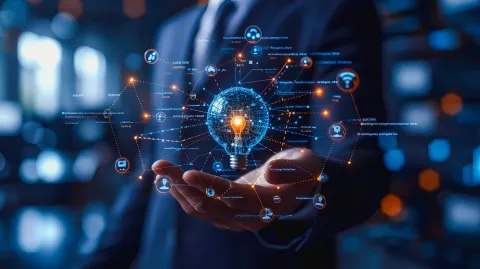Meet Your Digital Doppelgänger: How AI-Powered Digital Twins are Transforming Business
In this blog, we dive into the world of digital twins, where artificial intelligence (AI) creates virtual replicas of physical assets and systems. Let’s explore why AI is essential for creating digital twins, how they’re revolutionizing business operations, and what exciting developments we can expect in the future.
Why is AI Useful for Creating Digital Twins?
Imagine you had a clone that knew everything about you! That’s essentially what AI does for digital twins. AI’s ability to process and analyze vast datasets generated by physical assets or systems makes it the perfect brain for these digital replicas.
By leveraging AI algorithms, digital twins can accurately simulate the behavior, performance, and interactions of their real-world counterparts. This technology can forecast when a machine may fail and suggest maintenance before it happens, optimizing operations and preventing costly downtime. It’s the difference between reacting to a problem and anticipating it. The latter, thanks to AI, is now within our grasp.
How Are Digital Twins Changing the Way Businesses Operate?
Digital twins are shaking up the business world like never before, offering insights and capabilities to meet business demands.
Here’s how they’re doing it:
Predictive Maintenance - In manufacturing, digital twins continuously monitor equipment health, enabling predictive maintenance. This means fewer unexpected breakdowns, smoother operations, and significant cost savings.
Scenario Simulation - Digital twins can simulate different operational scenarios, helping businesses to optimize performance and make informed decisions. For instance, if you’re a manufacturer, you can test how changes in the production line might affect output without disrupting actual operations.
Supply Chain Optimization - In supply chain management, digital twins are revolutionizing logistics and inventory management. They ensure timely deliveries and minimize waste by providing real-time insights into the movement of goods.
What Can We Expect from This Technology in the Future?
The future of digital twin technology is full of potential, fueled by continuous advancements in AI, the Internet of Things (IoT), and connectivity.
Here’s a look at what’s on the horizon:
Enhanced Accuracy - As AI algorithms become more sophisticated, digital twins will offer increasingly accurate simulations and predictions. Businesses will be able to anticipate and mitigate risks with greater precision, making operations smoother and more reliable.
Real-Time Decision-Making - The integration of digital twins with emerging technologies like edge computing will enable real-time data processing and decision-making at the point of action. This means businesses can respond to changes instantaneously, enhancing their agility and competitiveness.
Broader Applications - Beyond manufacturing and supply chain management, digital twins will find applications in tons of other industries. We are already seeing growth of the technology in areas such as healthcare and product development.
In conclusion, AI-powered digital twins are not just a futuristic concept; they are a transformative force already reshaping how businesses operate. By providing unparalleled insights, enabling predictive maintenance, and optimizing complex processes, digital twins are helping businesses stay ahead of the curve. As we look to the future, the possibilities for this technology are endless.
Don’t miss out! Contact our team to see how we can help with your specific digital twin use case.
Latest Blogs
From Data to Action: How AI is Revolutionizing Decision-Making in 2025
In today’s rapidly moving business world, data is no longer just a byproduct of daily operations: it’s the bedrock upon which strategic decisions are built. But data, on its own, doesn’t provide the clarity needed to drive innovation, optimize processes, or enhance outcomes.
Embracing the Future: Mindbreeze’s Top 4 AI Trends for 2025
2025 is set to be transformative for AI, with advancements poised to revolutionize how organizations operate, collaborate, and innovate.


